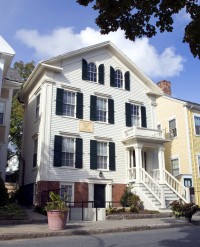View: Johnson House Video Tour
21 Seventh Street
Nathan and Polly Johnson, prominent African American abolitionists in New Bedford, sheltered escaped slaves in this Underground Railroad ‘station.’ It was here, in September 1838, that Frederick (Augustus Washington Bailey) Douglass found freedom, a new name, and with his wife Anna, his first home in freedom.

The Nathan and Mary (Polly) Johnson Properties at 21 Seventh Street and 17-19 Seventh Street have been designated a National Historic Landmark by the United States Department of the Interior. This designation came about as the result of the owners’ role in ante-bellum efforts to eradicate American slavery. They assisted escaped slaves, and, in particular, had a connection with famed abolitionist and orator Frederick Douglass.
After escaping slavery in Maryland, Frederick Augustus Washington Bailey and his wife, Anna (Murray), arrived in New Bedford on September 17, 1838. Fortuitously, they were met in Newport, Rhode Island by Quakers Joseph Ricketson and William C. Taber. Nathan Johnson, one of New Bedford’s most active abolitionists, who gave him refuge in his home at 21 Seventh Street and the name Douglass by which he was forever after known.
Records of the New Bedford Overseers of the Poor document that at least one other escaped slave found shelter at 21 Seventh Street. Based on Nathan Johnson’s anti-slavery activities in 1822, it is very likely that other fugitives were harbored in this house as well as in the first Society of Friends Meeting House at 17-19 Seventh Street, which was purchased by the Johnson’s circa 1830. Nathan Johnson (1797-1880), operated a store and was one of the City’s leading confectioners and his wife Mary (1784-1871) also known as Polly, was a well-known caterer.
The Nathan and Polly Johnson House is located within the County Street Historic District and was listed in both the National and State Registers in 1976. The Johnson House was purchased by the New Bedford Historical Society, with assistance from the Waterfront Historic Area League (Whale), and the Massachusetts Historical Commission in December 1998.
The Johnson House is actually two structures that were joined together during the 1850s, 1 circa 1820s structure and a circa 1857 structure that was added onto the earlier building. The front part was built in the attic. The rear portion resembles a vernacular Georgian/Federal building.
Preservation/restoration of the Johnson House is being programmed by the Society in three phases. The first phase, completed in June 2000, investigated the historical features of the property and resulted in the development of construction plans and specifications for the exterior repair/restoration of the Johnson House.
![]()
Thanks to our supporters who have helped us with the Johnson House Project:
1772 Foundation African American History Initiative
Cecil Lopes and New Bedford Floor Covering
Crapo Foundation
Island Foundation
Mass Humanities
MA Office of Travel and Tourism
National Trust for Historic Preservation
Network To Freedom National Underground Railroad Network
New Bedford Local Cultural Council
New Bedford Whaling National Historical Park
New York Community Trust
Eleanor Phillips
Youth Build




Trackbacks & Pingbacks
[…] of interracial cooperation in the fight to end slavery; the site lies across the street from the Nathan and Polly Johnson House, where Frederick Douglas lived when he first escaped […]
Comments are closed.